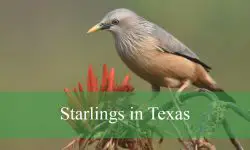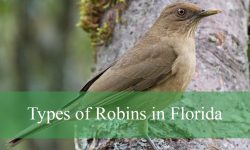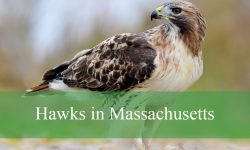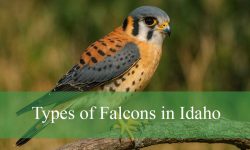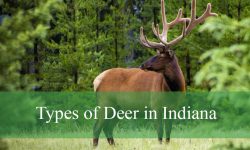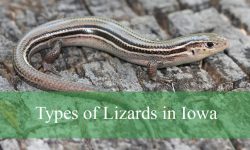Kansas bursts with life every summer, offering birdwatchers a chance to see a stunning variety of species. The Summer Birds of Kansas include vibrant songbirds, soaring raptors, and unique insect hunters that make the most of the state’s diverse habitats—from open prairies to wooded areas.
These birds bring color, sound, and energy to Kansas’s natural landscapes during the warm months. Learning to identify the Summer Birds of Kansas enhances outdoor adventures and helps deepen appreciation for the state’s rich wildlife.
This article showcases the top 20 Summer Birds of Kansas, complete with pictures and identification tips. From the bright plumage of the Indigo Bunting to the elegant flight of the Scissor-tailed Flycatcher, discover the birds that define summer across Kansas.
Best Summer Birds to spot in Kansas
Eastern Meadowlark (Sturnella magna)
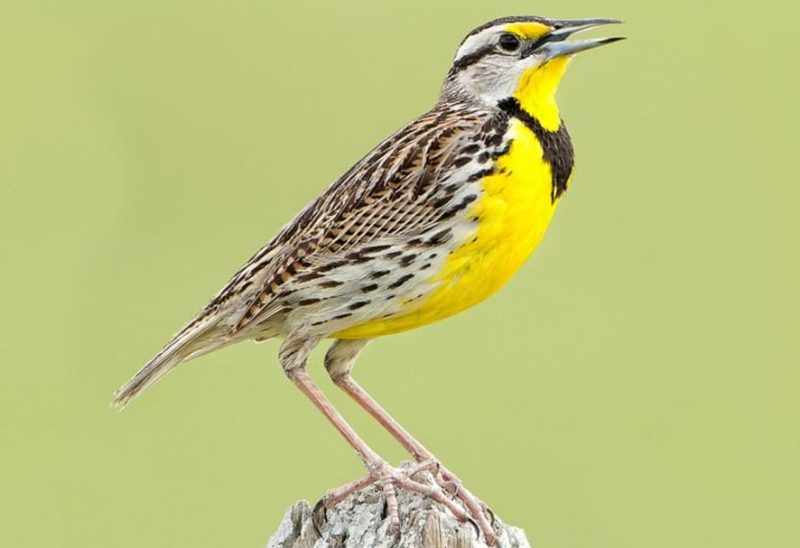
The Eastern Meadowlark is a striking songbird known for its bright yellow chest accented by a bold black “V” on its throat. Its back is brown with intricate streaking, which helps it blend in with tall grasses. Measuring around 8.5 to 10 inches in length, this medium-sized bird is often mistaken for a member of the blackbird family due to its similar size and shape.
This bird is most often seen in open habitats like native prairies, pastures, hayfields, and roadsides. In Kansas, it is a prominent summer resident, frequently spotted perched on fence posts or tall stems while singing its rich, flute-like melody. The Eastern Meadowlark’s song is clear and sweet, often heard before the bird is seen.
In terms of diet, the Eastern Meadowlark feeds primarily on insects such as beetles, grasshoppers, and caterpillars, though it will also consume seeds and grains. It nests on the ground, concealing its cup-shaped nest within dense vegetation. Kansas grasslands provide ideal breeding and feeding grounds during the summer months.
Scissor-tailed Flycatcher (Tyrannus forficatus)
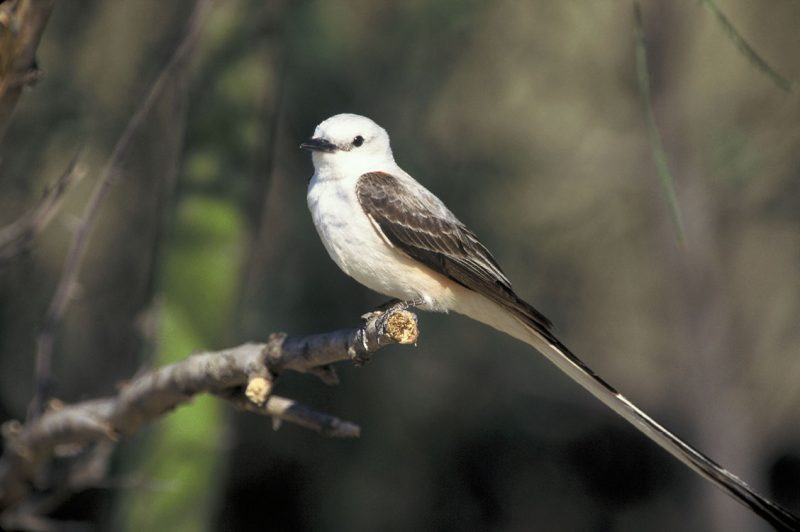
The Scissor-tailed Flycatcher is instantly recognizable thanks to its exceptionally long forked tail, which can be longer than its body. It has pale gray plumage with contrasting salmon-pink flanks and underwings, along with black and white in its wings and tail. This bird typically measures 10 to 15 inches in length, with males having longer tails.
During summer in Kansas, Scissor-tailed Flycatchers thrive in open areas such as ranches, grasslands, and agricultural fields. They are agile fliers and often seen performing acrobatic maneuvers as they catch insects in mid-air. These birds perch conspicuously on utility wires, fences, and shrubs, using them as launching pads for feeding.
Their call is a sharp, chattering “kip-kip-kip” and they are active, noisy residents in their breeding areas. Scissor-tailed Flycatchers feed mainly on flying insects, including grasshoppers, beetles, and wasps. They build cup-shaped nests in isolated trees, making Kansas an ideal summer home due to its wide-open habitats and abundant insect life.
Indigo Bunting (Passerina cyanea)
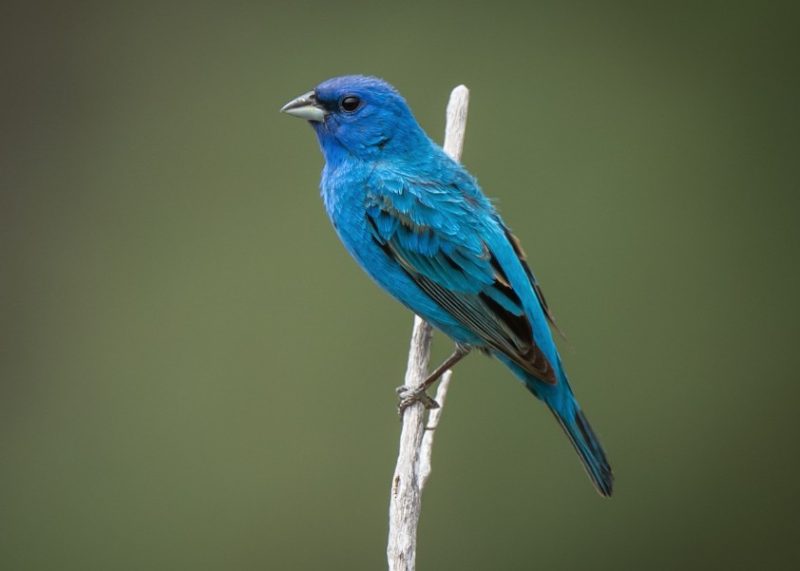
The Indigo Bunting dazzles with its vibrant, electric blue feathers, especially the males during the breeding season. Females, in contrast, are brown and subtly streaked, allowing them to blend into their nesting surroundings. This small bird measures about 4.5 to 5 inches long and has a thick, conical bill ideal for seed eating.
In Kansas, Indigo Buntings are widespread in the summer, favoring woodland edges, shrubby fields, hedgerows, and overgrown roadsides. They are most active at dawn and dusk when males sing persistently from exposed perches. Their song is a lively series of high-pitched warbling notes, often repeated with slight variations.
Though primarily seed eaters, they shift to an insect-rich diet during the summer, feeding on spiders, caterpillars, and small grasshoppers. Nests are well hidden in dense shrubs or low trees. The eastern and central parts of Kansas provide excellent breeding habitat for these striking birds from May through August.
Baltimore Oriole (Icterus galbula)
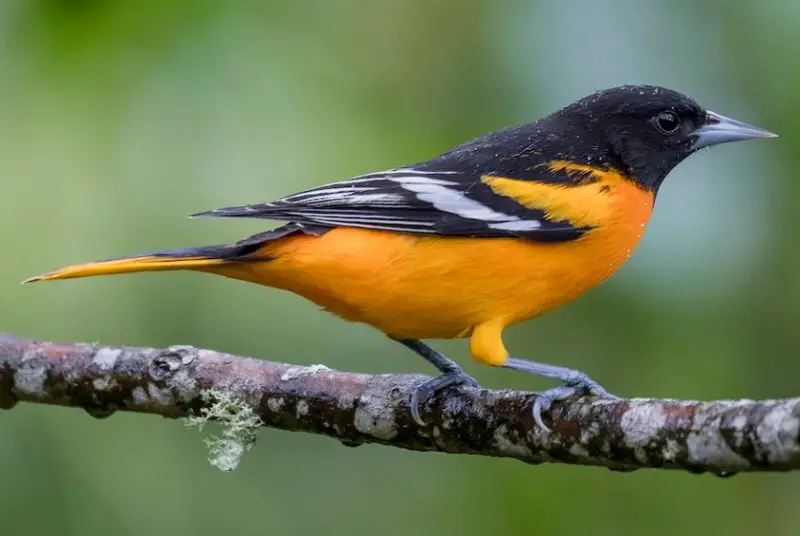
The Baltimore Oriole is a radiant bird with a flaming orange underside and black head and back in males, while females show a more subdued orange-yellow and grayish tone. Measuring around 7 to 8.5 inches, their slender bodies and slightly curved bills make them easy to identify among summer songbirds.
These orioles are common summer visitors in Kansas, especially in areas with tall deciduous trees like cottonwoods and maples. They often build elaborate hanging nests from plant fibers, suspended from the ends of high tree branches. Their melodious, flute-like songs and sharp call notes are often heard in suburban yards, parks, and riverside woods.
Baltimore Orioles feed on insects, ripe fruits, and nectar. In backyards, they are attracted to orange halves and jelly left on platform feeders. Kansas provides a perfect breeding environment for them in late spring and summer, as long as tall shade trees are present for nesting and food sources are plentiful.
Dickcissel (Spiza americana)
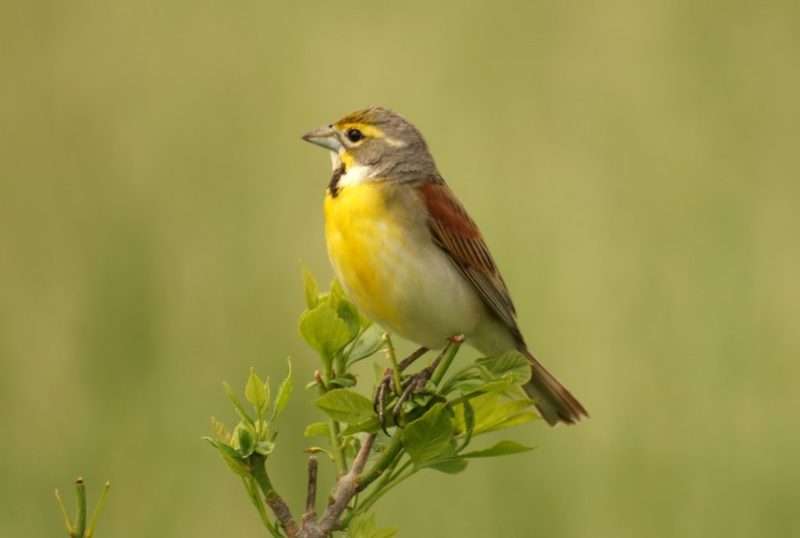
The Dickcissel is a small songbird that resembles a miniature meadowlark, with a bright yellow chest and a distinct black “V” mark on the throat. Its back is brown and heavily streaked, while the face often shows a grayish hue with a yellow eyebrow. Adults are about 6 inches in length and have a thick, conical bill adapted for seed consumption.
During summer, Dickcissels are abundant in Kansas, especially across native prairies, hayfields, and roadside grasslands. Males perch on fences or tall grasses and sing persistently with a distinctive “dick-dick-cissel” song, which helps them claim territory and attract females. Their song is loud and repetitive, carrying well across open fields.
Their diet consists primarily of insects and seeds. Dickcissels build their nests low in grasses or shrubs, concealed among dense stems. Kansas offers ideal breeding grounds for them, and their presence often signals healthy grassland ecosystems throughout the central and eastern parts of the state.
Western Kingbird (Tyrannus verticalis)
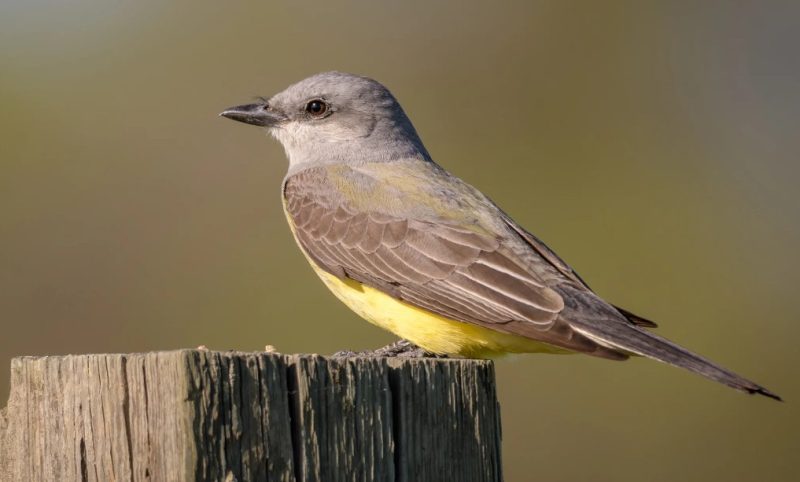
The Western Kingbird is a medium-sized flycatcher known for its pale gray head and chest, bright yellow belly, and white-edged tail. It measures about 8 to 9 inches long and is often seen sitting upright on fence wires or utility lines, scanning for flying insects.
These birds are widespread in Kansas during summer, particularly in open habitats with scattered trees, ranchlands, and suburban areas. Western Kingbirds are highly territorial and aggressive, frequently chasing away larger birds such as hawks or crows that wander too close to their nests. Their harsh, chattering calls add to their bold personality.
They feed mainly on flying insects like grasshoppers, beetles, and dragonflies, often caught in mid-air. Nests are usually built on horizontal branches of trees or man-made structures. Kansas provides the open space and insect abundance this species needs during its summer breeding season.
Common Nighthawk (Chordeiles minor)
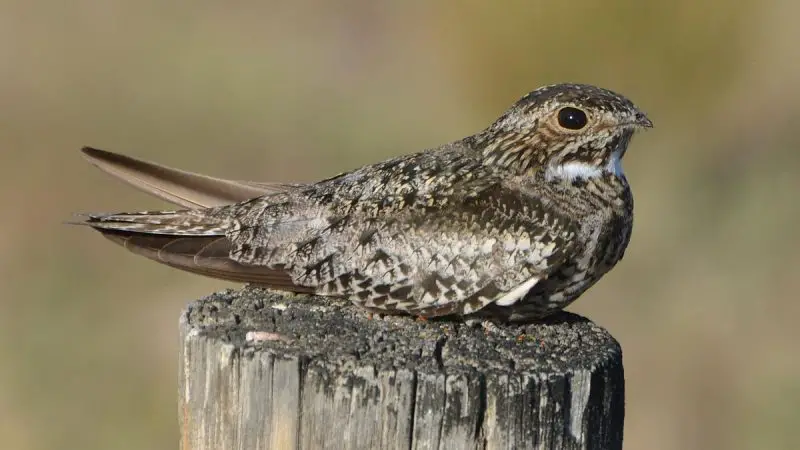
The Common Nighthawk is a slender bird with long, pointed wings and a cryptic mottled gray and brown body. It has a white bar across each wing that flashes visibly in flight. Though often mistaken for a hawk, it’s a member of the nightjar family and measures about 9 inches in length.
These birds are best seen at dusk or dawn in Kansas, when they take to the skies over towns, fields, and parking lots with erratic, bat-like flight. Males perform dramatic dives, creating a booming sound with their wings, while their nasal “peent” calls echo through the twilight. They rest on rooftops or gravel patches during the day, relying on their camouflage.
Nighthawks feed almost entirely on flying insects, especially moths and beetles. They nest directly on the ground, flat rooftops, or open gravel areas without building a typical nest. Throughout Kansas in summer, they are key insect predators and a familiar aerial presence in urban and rural areas alike.
Yellow-breasted Chat (Icteria virens)
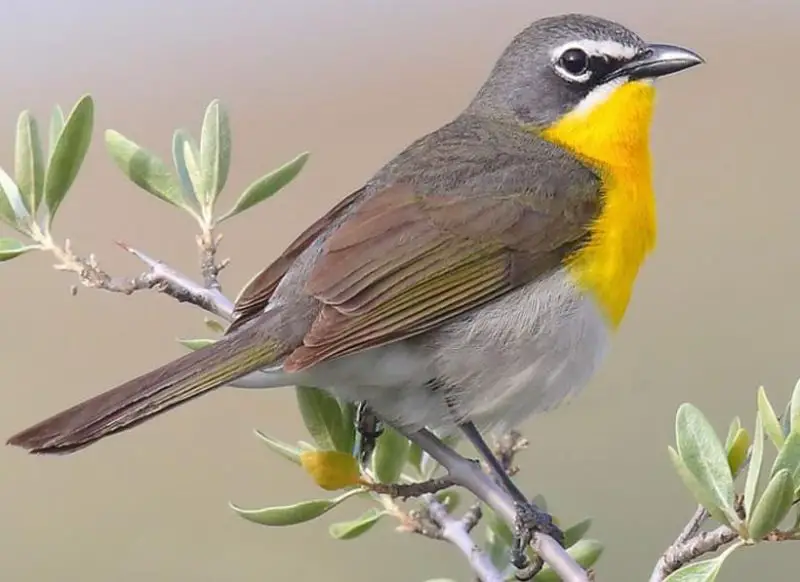
The Yellow-breasted Chat is the largest warbler in North America, with a chunky body, olive-green back, and bright yellow chest. It also has a white throat and striking white spectacles around its eyes. Measuring about 7.5 inches long, it often hides in dense vegetation, making it harder to spot than to hear.
In Kansas, chats are summer residents of brushy thickets, woodland edges, overgrown fields, and riparian zones. Though secretive in movement, males sing from semi-concealed perches and produce a bizarre mix of whistles, clucks, gurgles, and squawks. Their morning chorus is a defining sound of dense summer undergrowth.
Yellow-breasted Chats eat a varied diet of insects, spiders, and berries. They build nests low in shrubs and thickets, where they remain hidden. Their wide distribution across Kansas in the warmer months makes them an important part of the breeding bird community, especially in shrubby transitional habitats.
Blue Grosbeak (Passerina caerulea)
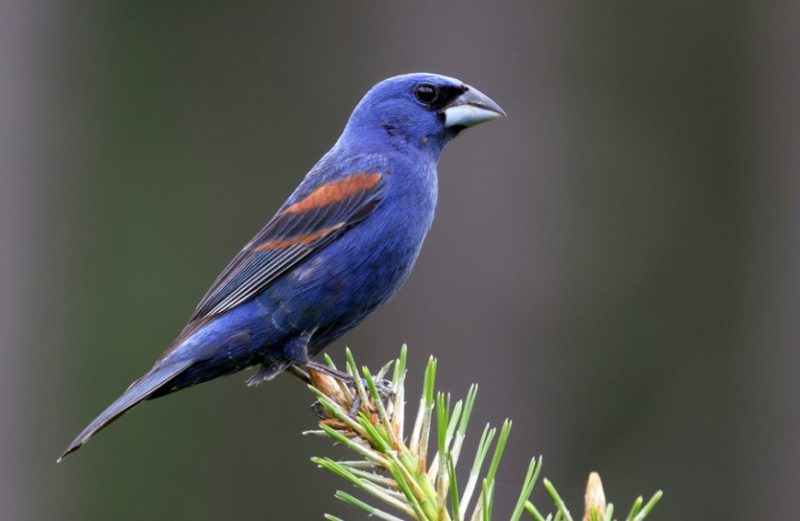
The Blue Grosbeak is a striking songbird with rich deep-blue plumage and bold chestnut wing bars. Females are brown with subtle blue tinges and similar wing markings. They are slightly larger than Indigo Buntings, measuring about 6.5 inches, and have thick, strong bills well suited for cracking seeds.
These birds breed in Kansas during the summer, favoring overgrown fields, woodland edges, and brushy roadsides. Males sing a sweet, musical warble from exposed branches or wires, often continuing their song through much of the day. Their voice is softer than other buntings but equally melodic and pleasing.
Blue Grosbeaks eat seeds, caterpillars, grasshoppers, and other small insects. Their cup-shaped nests are often placed in dense shrubs or small trees. Kansas provides suitable habitat throughout its central and southern regions, where these elegant songbirds brighten up summer mornings with both color and sound.
Mississippi Kite (Ictinia mississippiensis)
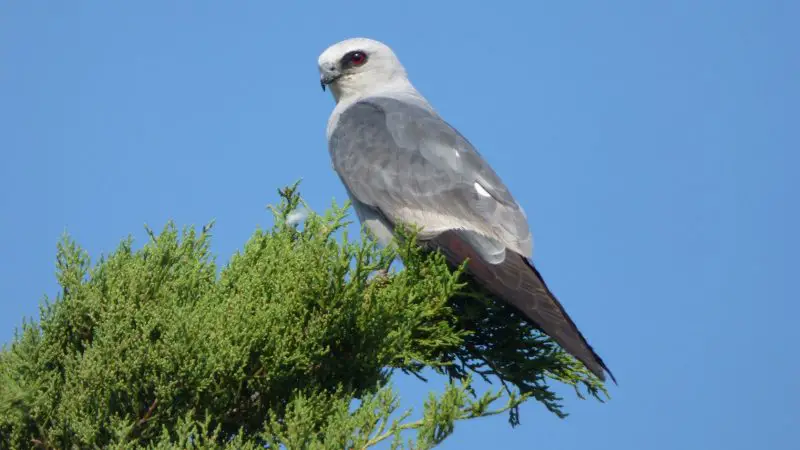
The Mississippi Kite is a sleek, gray raptor with long pointed wings and a graceful, buoyant flight style. Adults are pale gray with darker wingtips, while juveniles are streaked brown. They measure about 12 to 14 inches in length and have a light, agile build perfect for aerial insect hunting.
In Kansas, these kites are summer residents, especially in the southern and central parts of the state. They soar silently above towns, parks, and woodlands, effortlessly catching cicadas, beetles, and other insects mid-flight. Mississippi Kites are often seen gliding in small flocks or pairs, sometimes near residential neighborhoods.
They typically nest high in tall trees, including those in suburban areas. Their mellow whistles and elegant movements make them favorites among local birders. Kansas’s warm climate, abundant trees, and insect-rich skies make it one of the best places to observe this species during the breeding season.
Barn Swallow (Hirundo rustica)
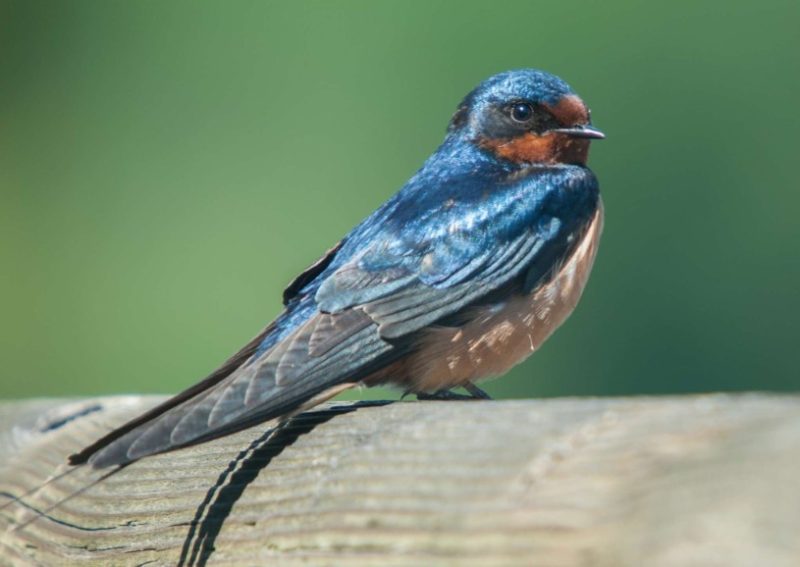
The Barn Swallow is easily recognized by its deeply forked tail, metallic blue upperparts, cinnamon-colored underparts, and fluid, acrobatic flight. Measuring around 6.5 to 7 inches long, it is slender and streamlined, built for speed and agility in the air.
In Kansas, Barn Swallows are common throughout the summer, nesting under eaves, bridges, barns, and other sheltered structures. They build cup-shaped nests out of mud and grass, often returning to the same nesting site year after year. These birds are highly social and often nest in loose colonies.
Their diet consists entirely of flying insects, which they catch while swooping over open fields, lakes, and roads. Barn Swallows are tireless feeders and valuable for natural pest control. Their constant chatter and graceful flight make them one of the most beloved and visible summer birds in Kansas.
Red-headed Woodpecker (Melanerpes erythrocephalus)
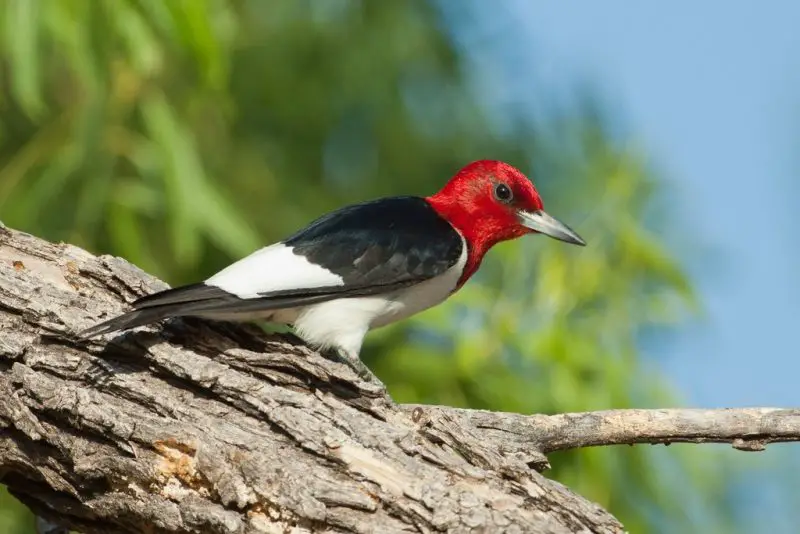
The Red-headed Woodpecker is a visually striking species with a bright crimson head, snow-white body, and black wings with bold white patches. It measures about 7.5 to 9 inches long and has a stout bill used for drumming and probing.
In summer, these woodpeckers are frequently found in open woodlands, groves, and scattered trees in rural Kansas. They are particularly fond of oak savannas and dead trees where they can find insects, store food, and create nest cavities. Unlike many other woodpeckers, they are strong fliers and often seen catching insects in mid-air.
Their diet includes insects, berries, acorns, and even small rodents or birds on occasion. Red-headed Woodpeckers are also known for storing food in tree crevices. Their bold colors, active behavior, and loud tapping sounds make them easy to spot and hear during the summer months.
Orchard Oriole (Icterus spurius)
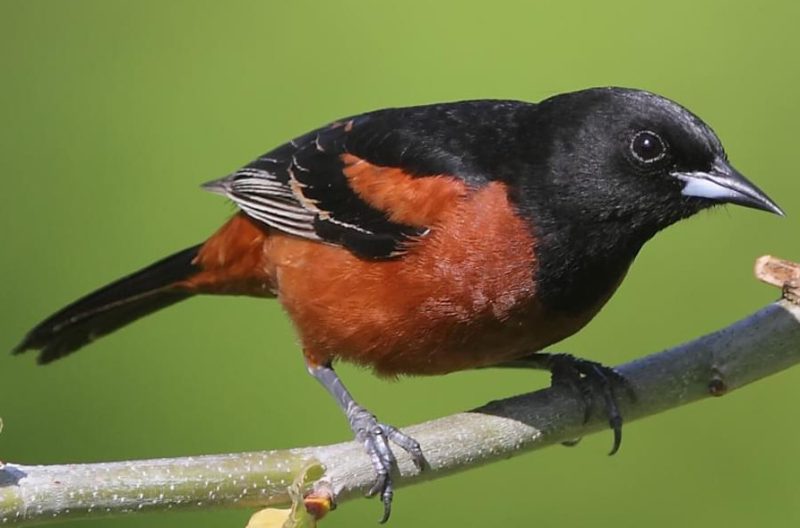
The Orchard Oriole is a smaller, darker cousin of the Baltimore Oriole. Adult males have deep chestnut-orange underparts and a black head and back, while females are olive-yellow with dusky wings. They are about 6.5 to 7 inches long and have a slim body and pointed bill.
During summer, Orchard Orioles are commonly found across Kansas, especially near open woodlands, riverbanks, and farm edges where large deciduous trees are present. They are often heard before being seen, singing soft, melodic warbles from high perches in the canopy. Their woven hanging nests are suspended from slender tree branches.
These orioles feed on insects, spiders, nectar, and fruits. Though more secretive than their brighter relatives, they are reliable summer residents throughout the state. Their preference for edge habitats makes them well-suited to the mix of rural and suburban landscapes found across Kansas.
Great Crested Flycatcher (Myiarchus crinitus)
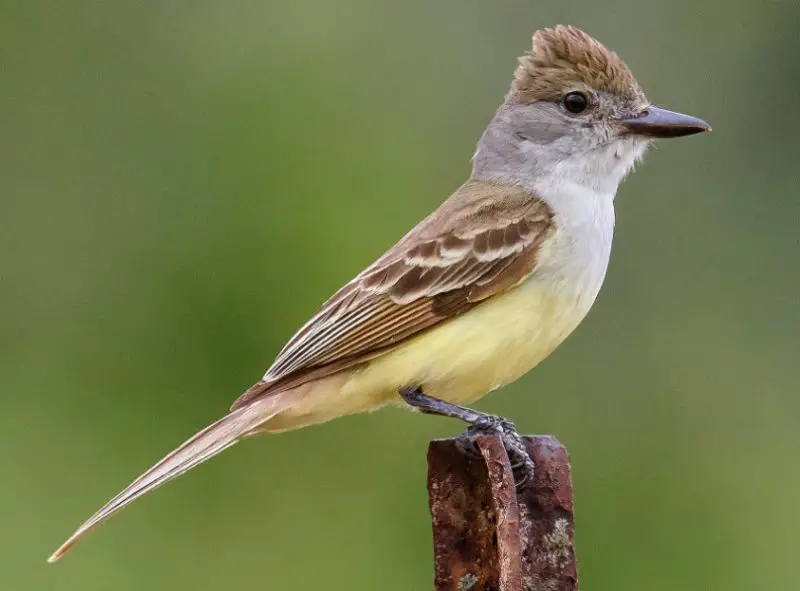
The Great Crested Flycatcher is a large, bold flycatcher with a bushy crest, gray head and chest, bright yellow belly, and reddish wings and tail. It measures about 7 to 9 inches in length and has a commanding presence in the canopy.
In Kansas, this species breeds in mature woodlands and along forest edges, where it nests in natural cavities or old woodpecker holes. It is most active in the treetops, where it perches upright before darting out to catch flying insects. Its harsh, whistling “wheep” call is a clear sign of its presence.
The Great Crested Flycatcher eats mostly insects but will also take small fruits and berries. It is known for adding unusual items to its nest, including snake skins. Though not always easy to see, its voice and behavior make it a distinctive part of Kansas’s summer birdlife in wooded habitats.
Eastern Kingbird (Tyrannus tyrannus)
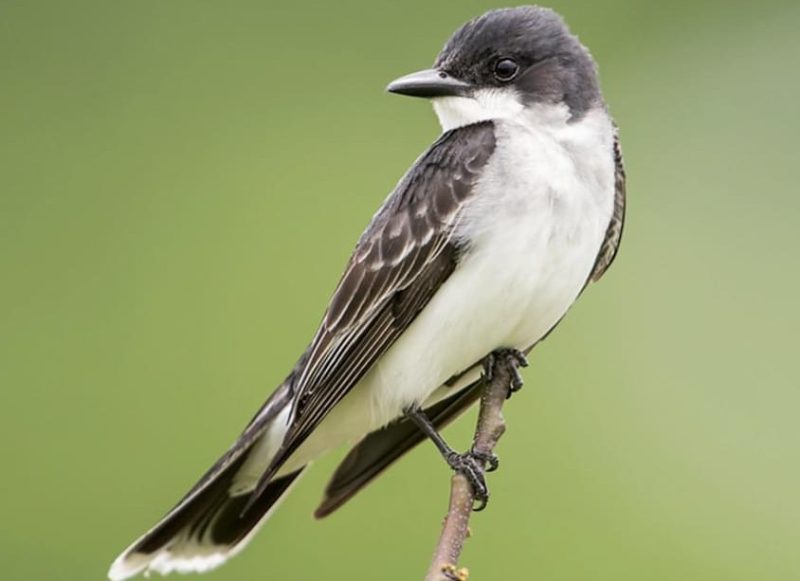
The Eastern Kingbird is a striking flycatcher with dark gray upperparts, a contrasting white belly, and a square black tail edged in white. It measures about 7.5 to 9 inches long and has a compact, upright posture with a slightly notched tail.
These birds are common throughout Kansas during the summer breeding season, especially in open country, fields, orchards, and along streams. They often perch on fence posts, wires, or exposed branches as they wait to launch at passing insects. Eastern Kingbirds are fearless and territorial, frequently chasing off much larger birds.
Their diet consists almost entirely of flying insects such as bees, wasps, and dragonflies. They also eat berries later in the season. With their energetic flight, sharp calls, and assertive behavior, Eastern Kingbirds are a lively presence in the rural landscapes of Kansas throughout the warm months.
Yellow Warbler (Setophaga petechia)
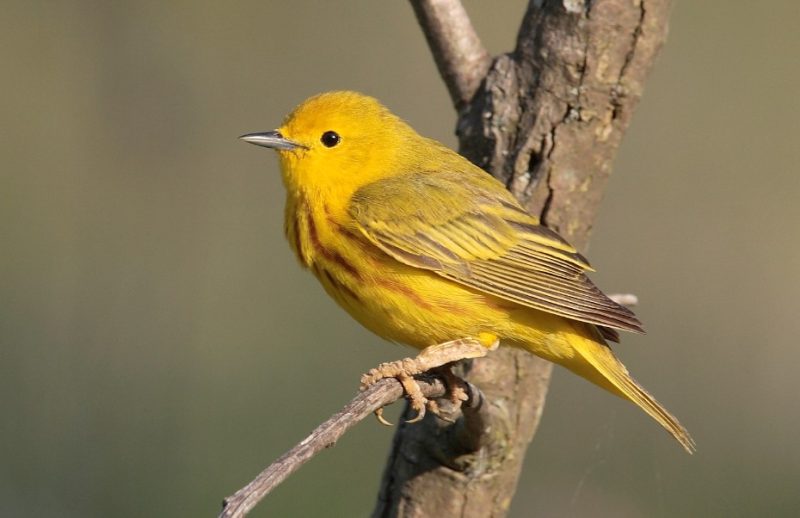
The Yellow Warbler is a radiant little songbird covered almost entirely in bright yellow plumage, with reddish streaks on the chest of adult males. Females are slightly duller but still show vibrant yellow tones. Measuring about 4.5 to 5 inches long, it is one of the most recognizable warblers during the summer.
In Kansas, Yellow Warblers are frequently found near streams, wetlands, and shrubby thickets, especially where willows or cottonwoods grow. They are active and agile, often flitting through foliage in search of insects. Males sing a cheerful, whistling song that sounds like “sweet-sweet-sweet, I’m-so-sweet.”
Their diet is mostly composed of caterpillars, midges, and other soft-bodied insects. Nests are built in shrubs or small trees, often well-concealed in dense vegetation. As a common breeding species throughout Kansas in summer, the Yellow Warbler brings color and song to many wet, brushy habitats.
House Wren (Troglodytes aedon)
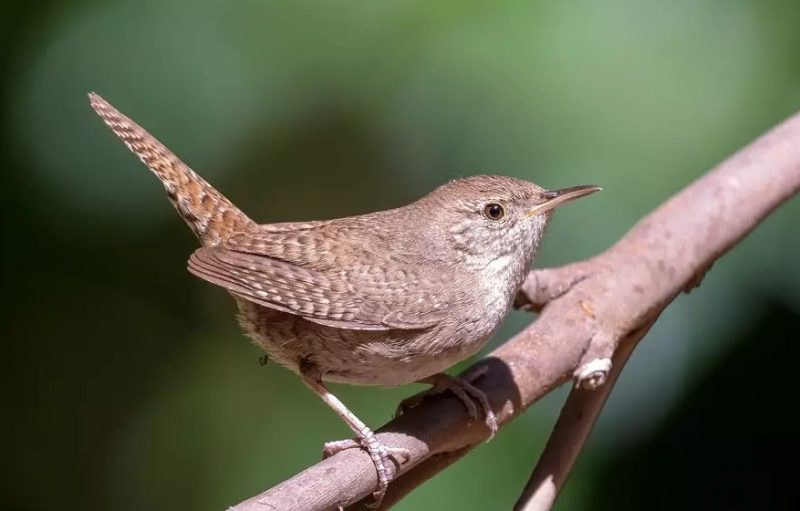
The House Wren is a tiny, energetic bird with a plain brown body, short wings, and a perky tail often held upright. Though only about 4.5 inches long, it makes up for its size with a powerful, bubbly song that rings out loudly from gardens and woodlots.
This species is a familiar summer resident throughout Kansas, commonly nesting in cavities such as tree holes, fence posts, birdhouses, and even old cans or boots. House Wrens are extremely vocal during the breeding season, with males singing constantly to establish and defend their territory.
They feed on a wide variety of insects and spiders, helping control pests in backyard habitats. Their nests are loosely made of twigs and lined with softer material. These wrens are resourceful, adaptable, and often one of the most conspicuous voices of summer in both rural and urban areas.
Common Yellowthroat (Geothlypis trichas)
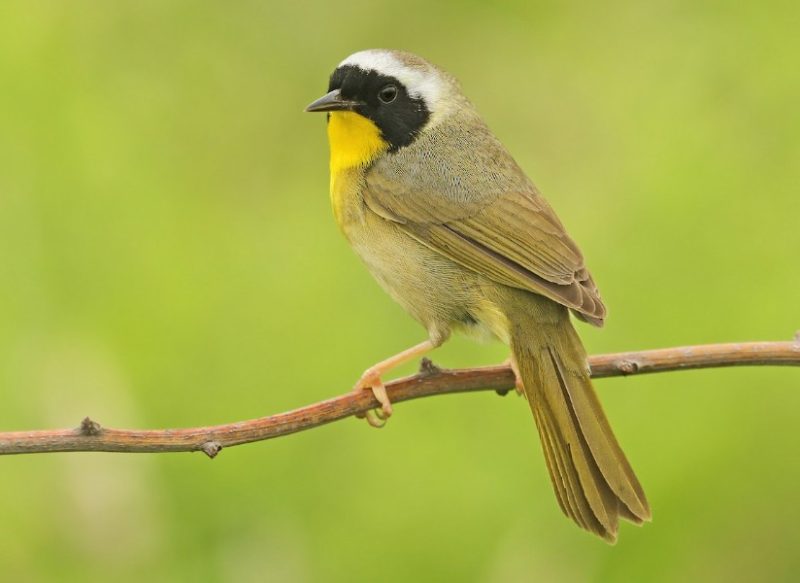
The Common Yellowthroat is a small warbler with a bright yellow throat and underparts. Males are easily identified by their bold black facial “mask,” edged in white, while females lack the mask and are more subtly colored. They measure around 4.5 to 5 inches long.
In summer, Common Yellowthroats are abundant in Kansas wetlands, marshes, wet meadows, and dense thickets near water. They are secretive birds, staying low in vegetation, but their loud “wichity-wichity-wichity” song gives away their presence. Males often pop up briefly to sing before diving back into cover.
Their diet includes beetles, caterpillars, and other small insects, which they forage for in thick undergrowth. They nest close to the ground in tall grasses or shrubs. As summer breeders across much of Kansas, Common Yellowthroats are important indicators of healthy wetland edge habitats.
Eastern Bluebird (Sialia sialis)
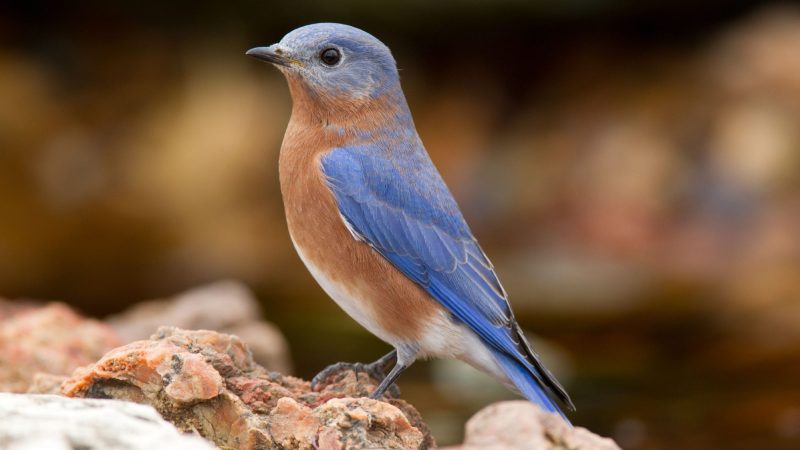
The Eastern Bluebird is a stunning species with bright blue upperparts and warm reddish-orange on the throat and chest. Females are grayer but still show hints of blue and rust coloring. They measure about 6.5 to 7 inches in length and have a slim, upright posture.
During summer in Kansas, Eastern Bluebirds are widespread in open areas with scattered trees, such as pastures, parks, and field edges. They readily use nest boxes and are a favorite among backyard birders. Their soft warbling song and gentle calls are a welcome soundtrack in quiet rural settings.
They feed primarily on insects, including beetles, crickets, and caterpillars, but also eat fruits later in the season. Eastern Bluebirds often raise two or more broods per summer, and Kansas’s patchwork of fields and woods provides ideal breeding territory for this iconic and beloved species.
Bell’s Vireo (Vireo bellii)
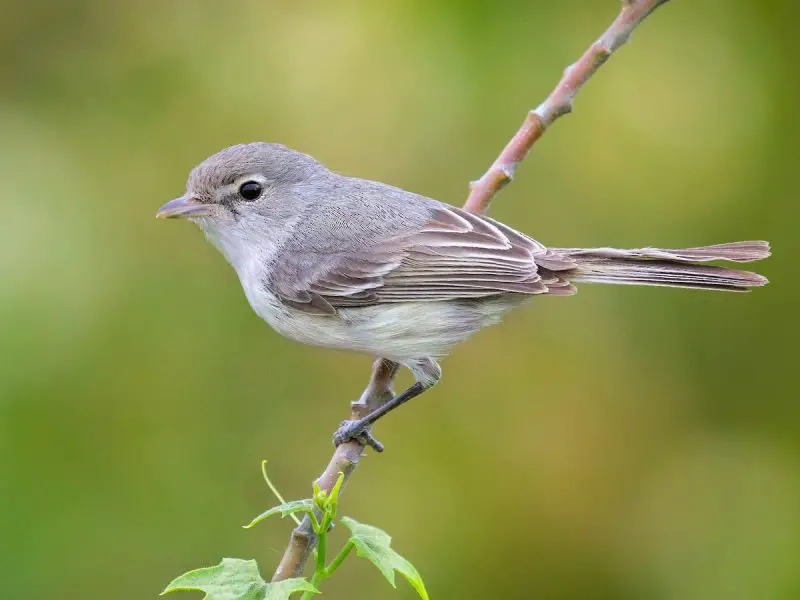
Bell’s Vireo is a small, inconspicuous bird with pale gray upperparts, whitish underparts, and faint wing bars. It measures around 4.5 to 5 inches in length and is more often heard than seen due to its secretive nature and preference for dense brush.
In Kansas, this vireo breeds during the summer in shrubby grasslands, dry thickets, hedgerows, and riparian scrub. It sings a rhythmic and bouncy song made up of jumbled phrases, which males repeat frequently from within cover. The song often reveals their presence long before the bird is visible.
Their diet consists mainly of small insects and caterpillars. Nests are built low in shrubs or small trees and are cup-shaped and well-hidden. Bell’s Vireo is a characteristic summer breeder in central and western Kansas, thriving in areas with native shrubs and minimal tree cover.
FAQ about Summer Birds of Kansas
What are some of the most common summer birds in Kansas?
Some of the most common summer birds in Kansas include the Eastern Meadowlark, Scissor-tailed Flycatcher, Indigo Bunting, Baltimore Oriole, Barn Swallow, and Eastern Bluebird. These species are frequently seen in grasslands, open fields, woodlands, and even backyards during the warm months.
When do summer birds arrive in Kansas?
Most summer birds begin arriving in Kansas between late March and early May, depending on the species and weather patterns. Peak breeding activity typically occurs in May and June, and many birds remain through August before beginning their fall migration.
Where can I go birdwatching in Kansas during the summer?
Great places to watch summer birds in Kansas include tallgrass prairies, state parks, wildlife refuges, and riparian woodlands. Areas like the Flint Hills, Cheyenne Bottoms, and Marais des Cygnes Wildlife Area offer excellent opportunities to see a wide variety of breeding birds.
How can I attract summer birds to my backyard in Kansas?
You can attract summer birds by planting native shrubs and flowers, providing fresh water sources like birdbaths, and offering food such as fruit, jelly, nectar, or mealworms. Nest boxes also help attract species like bluebirds, wrens, and swallows.
What do summer birds in Kansas eat?
Most summer birds feed on insects, which are plentiful during the warmer months. Some also consume fruit, nectar, and seeds. For example, flycatchers catch flying insects, orioles enjoy fruit and nectar, and warblers pick insects off leaves and twigs.
Are there any colorful birds to watch for in summer?
Yes, summer in Kansas is a great time to see colorful species such as the Indigo Bunting, Baltimore Oriole, Blue Grosbeak, and Yellow Warbler. Males of these species display bright plumage to attract mates during the breeding season.
What is the best time of day to observe summer birds?
Early morning is typically the best time to observe birds, as they are most active and vocal at dawn. Evening can also be productive, especially for species like nighthawks and kites that forage during twilight.
Are any summer birds of Kansas endangered or declining?
Some summer birds, like the Bell’s Vireo and Common Nighthawk, have experienced population declines due to habitat loss and environmental changes. Conservation of grasslands, wetlands, and nesting areas is crucial to maintaining healthy bird populations.
Do summer birds in Kansas migrate?
Yes, most summer birds in Kansas are migratory. They arrive in spring to breed and raise young, then migrate south in late summer or early fall. Some, like the Scissor-tailed Flycatcher and Baltimore Oriole, travel long distances to Central or South America.
Can I report bird sightings in Kansas?
Yes, birdwatchers can report sightings to platforms like eBird or through local Audubon chapters. Reporting observations helps scientists track migration patterns, population changes, and habitat use.

